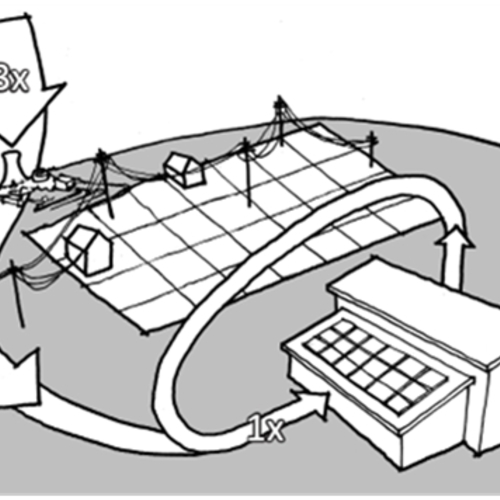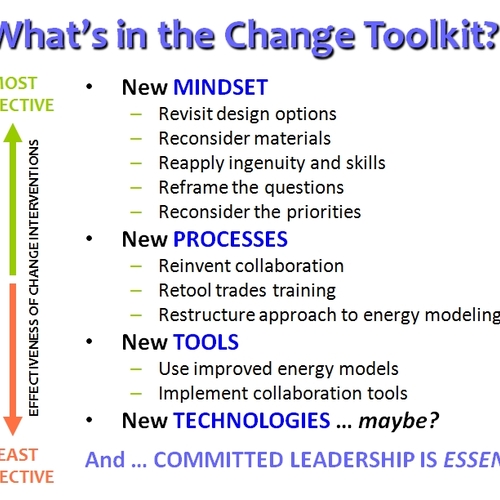Image Credit: Will Lichtig
In days of yore, buildings were designed and built by master builders. These were people who spent their whole lives learning about buildings by creating them – from idea to reality – working side by side with others, many of whom who had more experience than they did. That’s how they eventually achieved mastery. Practice, repetition, and observation of everything to do with the building’s creation.
As centuries have passed, our work has become increasingly specialized. Two byproducts of specialization are fragmentation and loss of breadth. Another artifact of specialization is the sequential hand-off model of building development:
- Owner conceives of project;
- Architect conjures up design – typically with strong emphasis on form and program;
- Structural engineer figures out how to make it stand;
- Mechanical consultant sorts out how to make it (marginally) comfortable;
- Landscape consultant selects growies to put around the edges;
- Interior designers and lighting designers work out how to make it attractive and pleasant inside;
- Contractors have to actually build it.
If you’re one of these professionals, please don’t take umbrage at this unflattering characterization of your work. Through no fault of our own, all of our contributions are often reduced to this level – in no way because that’s how it should be, and many of us have opportunities to contribute more effectively on the occasional project. But too often all the players in the design and construction process have limited opportunities to influence the building for the better, simply due to the nature of this hand-off process.
Of course I’m oversimplifying, and there is some back-and-forth among project team members. But the cold, hard reality is that our opportunities to interact – and to share with one another the benefits of our experience and insight – are far too few. And our buildings suffer as a consequence. Each of the players in the process inherits and has to solve, often solo, problems unwittingly created by well-meaning teammates who are higher up the food chain. How many times have you thought, “If only they’d asked me about that!”?
Integrating the design team and the construction team
We may accept this process as inevitable for garden-variety projects, but it is the death knell for high performance. Stated differently, the green building community has long since arrived at the collective observation that high performance is most readily achieved through the process of what is often referred to as either “integrated design” or “integrative design.”
Over time, I have developed a strong preference for “integrated project delivery.” I realize that this may mean something somewhat different to others in my industry, but what it means to me is that the building is delivered (designed and built) by a team working via an integrated process throughout both design and construction. My final boldface phrase deserves repetition: design and construction.
Developing a common understanding
There are some critical components to integrated project delivery (IPD). For my 2009 book, Energy Free: Homes for a Small Planet, I mined several sources to hone a couple of definitions to support my understanding of IPD:
- An integrated team is one that is unified by coming together to work as a whole; and
- In an integrated building, the building components and their interconnections are brought together into a unified whole.
As these definitions suggest, integration is an important attribute both of the team and of the building they collaborate to produce. And it reasonably follows that it’s hard to get an integrated building without an integrated team and team process.
Possibly the best explanation of this that I have found comes from a somewhat surprising source: a lawyer. Attorney Will Lichtig produced the diagrams shown in Image 1. Perhaps he was drawing from painful experience (building processes that were not integrated?).
As Lichtig’s graphs so effectively highlight, the critical distinction between business as usual and integrated project delivery is that during IPD, common understanding among team members (including the general contractor and trades) is achieved very early in the design process. It’s easy to see, then, how much easier it is to meet high performance goals, when everyone on the team is party to design accords and – perhaps even more importantly – participates in reaching those accords.
Integrating not just design, but project delivery
This is why I’ve shifted my thinking over the past couple of years from “integrated design” to “integrated project delivery.” When the building team isn’t privy to the reasoning behind design decisions – and may in fact have good reasons to quibble with some of those decisions – field implementation may not occur precisely as envisioned by the designers. By contrast, when the building team participates in design, the team has the full benefit of expertise on constructability issues – including cost implications – and can therefore make decisions that are much better-informed and are likely to be much more faithfully executed during construction.
 
This explains why high performance – or zero net energy (ZNE) – is a recessive gene (click on Image 2 below).
Having now belabored the rationale behind integrated project delivery, the question remains: how to implement this process in your projects? I’ll offer some suggestions and resources on this subject in my next installment.
Weekly Newsletter
Get building science and energy efficiency advice, plus special offers, in your inbox.
















15 Comments
Room, elephant.
Integrated project delivery is a great description of the necessary process for producing excellent work in almost any field (look at Apple) and high performance residential construction is no exception. I'm looking forward to what more you have to say about this.
The elephant in the room of course is the competitive bid process which is continually reinforced in the mainstream literature as the only way for homeowners to make sure they're not being cheated. Multiple competitive bid as a contract device makes it pretty much impossible to bring GCs and appropriate subs into the discussion at the early stages of design development when their contribution and their buy-in is critical. Our design practice has had to work to correct this misperception with almost every client for two decades now: many of them get the message, but by no means all.
That elephant
I LOVE it when someone anticipates my next comment!! Yes, I'll definitely be talking about that in installment #5. So glad you raised it.
LEED
absolutely concur! Reviewing our experience doing a LEED project, we found the design charettes that were required even before and during the build process to be possbly one of the best features of LEED. I must admit that I had trepidation anbout how the various trades, GC and architech would react. After all they were being asked to attend meetings that they couldn't directly bill for, which I feared they would view as a waste of their time. Interviewing them later, they were all very excited by the process and had much to contribute along the process. I have learned since that for architects in Europe this is the norm!
charrettes
Kevin, we also find that the vast majority of our LEED project teams find the charrettes to be tremendously helpful and stimulating. I typically pitch it to as a free continuing education opportunity that's scheduled at the consultants' convenience -- what could be better? Most recognize it's in their interest to learn more about 'this green thing' and so are eager to participate.
Tooting my own horn
I wrote a piece for JLC last year on the bid process and why it doesn't get anyone what they want. I've been refining it since then for why it's even more important for projects with energy efficiency goals - I've come to the same conclusions as Ann. I'm happy to share my piece - e-mail me at dan at kolbert building dot com
Good piece, Ann - I look forward to the next ones.
broken bid process
I'll be looking forward to seeing that article, Dan! It may end up in one of my presentations! :)
But wait, there's more
I've also got a power point on Assembling the Design-Build Team for High-Performance Residential Projects, full of bad jokes and insulting photos of architects and engineers!
PPT
I gotta have that, too!! :)
Two Stage Process
I completely agree that an integrated approach is the way to go and I plan to use it for my new home. A two stage process might be the solution to the integrated design vs. traditional bidding approach.
First stage you identify the architect, general contractor and engineer you want to work with (do your homework, ask for references and check them). Go through the design process with the team with estimates at each level of design. The major trades will be happy to work with the team on options for the chance to eventually get the job. You pay the architect and engineer for each completed pre construction stage of his/her work (reserving the right to fire them at any stage). The general contractor provides the estimates. Once the working drawings are done you ask for a firm price from the contractor.
Stage two: You reserve the right to bid out the project to other builders. If you select another builder you pay the original builder an already negotiated fee for his pre construction services. I think this process will ensure that the client gets both the best design and the best price.
two stages
I've spoken to a good number of people who have taken this approach with good results.
Pay the Contractor!
I have been arguing for this process for years. I think, though, that the contractor should be paid. S/he is essentially acting as a consultant during the design phase and should be compensated as such.
If the GC gets the job and wants to have a clause stating that the consulting fee will be credited toward the job, fine. But part of the problem with the current approach is that it assumes that the contractor has little to nothing to add to the design process. Paying people seems to be the most obvious way of showing we value them.
And my offer of my article was to anyone who wants it, not just Ann.
the two stage process
I've reached another bit of agreement that is helping --
my GC is also a RESNET rater and affiliated with a local (SE) energy design firm. He is charging me hourly for design; if he gets the contract he will deduct what I've paid from his contract. "It will be time I won't have to spend," he says.
I like it. We both have an incentive to continue, which I don't mind. In addition, he's already vetted his subs as they've built several certified homes in the area. He agrees with Ann, too. Before design is firmed up, he will have a meeting for his subs with me present.
banish the bid!
This is all great information -- thanks to you all for sharing! Many of us (and our clients) will benefit.
Banish the Bid. Amen!
I think while those of us on GBA support this, there is still a disconnect between architect, builder, owner in many parts of the country. In our area there is not much enthusiasm (read: enlightenment) on the design and production side for energy efficiency in new construction. A few LEED projects here and there and Energy Star (but a lot of talk about being EStar 3 being too "restrictive").
My preferred method of delivery is Design/Build, but have recently looked at 2 architect designed projects (for the last few years, I have lived off of Energy Retrofits...,). Both are nearly finished design and though it's a bit late, I have discussed IPD with the owners. Both seemed agreeable, but had been advised only on the "design, bid, build" approach. There are glaring holes (some quite literally in the thermal barrier) in the designs. There are the usual suspects: lack of clear air barrier, foam sandwiches, thermal bridging, grossly oversized A/C units. One in particular has a commercial range with an 1,100 cfm range hood on it. I asked about the make up air unit (that's part of the code now and is not addressed on these particular plans), and it will be "supplied by the kitchen shop"---that's their "bailiwick". I hope so.
I went to Design/Build in part to avoid the enmity that can exist in the design/bid/build model. I also don't like the free consulting that has become expected from Builders. As Joe W. has stated, that his builder has "vetted his subs as they've built several certified homes in the area". I too have done that, in particular on the HVAC side. There are less than 2 in this area (yes, just 1) that understands it. He's also a HERS rater and BPI certified. What does he bring to the (pre-planning) table? Certainly more than a proposal.
I applaud Elizabeth K's idea of the 2 stage process, but I would suggest a thorough vetting of potential builders and their respective teams and be willing to pay upfront for their consultation time (just as you presumably did with your architect). Successful projects have good teams that work together.
And you may want to be wary of firing your architect. Unless he has specifically given his copyright of your plans to you, you may have to start the process all over again, blank page, no derivative works. Copyright law is pretty clear about this. At the very least, check your contract on how a split between the two of you will be resolved in terms of the design.
Amen John Zito. I too
Amen John Zito. I too design/build with subs I know and I am the one who sets up what and how the subs perform their work.
If I did do an Architect project I would like to be hired for all time spent upfront and at that point could work with the above ideas.
Log in or create an account to post a comment.
Sign up Log in